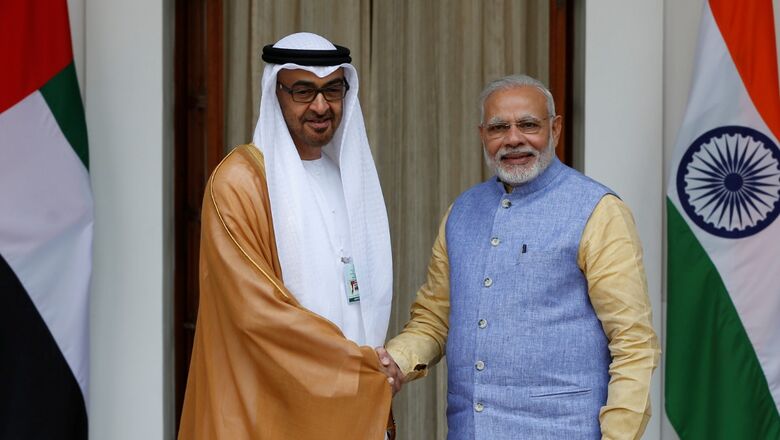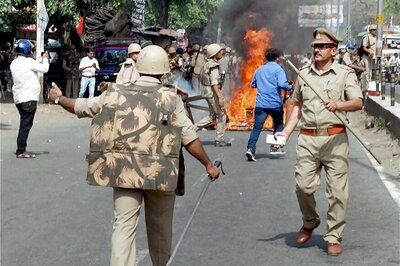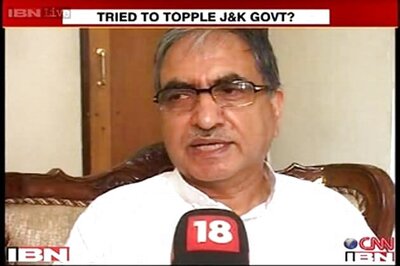
views
January 9, 2024 will herald the dawn of an ambitious new phase in the longstanding partnership between India and the United Arab Emirates. Prime Minister Narendra Modi and UAE President Sheikh Mohammed bin Zayed Al Nahyan will embark on a landmark roadshow from Ahmedabad airport to the iconic Sabarmati Ashram. Their journey through the streets of Modi’s home state Gujarat, which will also host the Vibrant Gujarat summit on January 10, will serve as a preview of closer collaboration to come.
As the leaders pay homage to Mahatma Gandhi at Sabarmati Ashram, they will also commemorate the civilisational bonds between the two countries while charting a future defined by ever closer economic, strategic and people-to-people ties. Sheikh Mohamed’s participation at the high-profile Vibrant Gujarat Global Summit lends further gravitas to this new phase in the partnership.
High-level visits averaging one per year have firmed the foundation, with Prime Minister Modi having visited the UAE five times since assuming office in 2014. With the inauguration of BAPS Hindu Mandir on February 14, where PM Modi will officiate the ceremony, the count of visits will go up to six.
The foundation stone of the Hindu Mandir was laid on April 20, 2019. The history of this project can be traced back to the visit of Prime Minister Narendra Modi in 2015, during which the UAE government allocated the land for the temple.
On February 13, Modi will address the mega diaspora event ‘Ahlan Modi’ or ‘Welcome Modi’ in Abu Dhabi. The event is expected to be one of the largest gatherings of the Indian diaspora, with an estimated 50,000 attendees. The UAE, home to the largest number of Indian diaspora anywhere in the world, boasts of a population of 3.3 million Indians.
The Modi-MBZ roadshow and Sheikh Mohamed’s attendance at Vibrant Gujarat highlight how far India-UAE relations have progressed. What began in 1972 as a partnership rooted in historical trade connections has evolved into a comprehensive strategic alliance.
Vibrant Gujarat and the Roadshow in Dubai
Modi initiated the Vibrant Gujarat Summit in 2003 during his chief ministerial tenure. Over the years, the summit has become a crucial platform, drawing top-tier business leaders, investors, and policymakers. Its growth in each edition underscores its pivotal role in advancing India’s economic agenda. The event consistently allures foreign leaders and investors, positioning Gujarat as a prime investment destination.
This year’s summit, schedule to open on January 10, is already off to a great start with the signing of pre-summit MOUs worth Rs 7.12 lakh crore.
The Vibrant Gujarat roadshow in Dubai was one of the biggest highlights which generated a lot of attention and grabbed eyeballs across the world. It saw the participation of over 130 delegates spanning various sectors such as financial services, sovereign funds, healthcare, renewable energy, and academia. The roadshow explored opportunities in rapidly emerging economic hubs like Gujarat International Finance Tech City (GIFT City), Dholera SIR, DREAM City, Renewable Energy Park, and various tourist locations within Gujarat. Industry experts shared their experiences about the ease of doing business in Gujarat.
Following the roadshow, one-to-one meetings and roundtables took place with over 15 potential investors expressing interest in expanding their operations in Gujarat. These sessions provided a platform for senior management representatives of renowned organizations such as DP World, Sharaf Group, Emaar, shipping lines, alternate funds, USky Transport, RAK companies, and Dubai Chamber of Commerce to engage in discussions regarding potential collaborations and investments with the Gujarat government.
In June 2016, UAE became the first Gulf partner in the Vibrant Gujarat Global summit, participating in the 2017 and the 2021 Vibrant Gujarat Global summit. UAE has invested $2.07 billion in Gujarat. In FY 2022, Gujarat exported goods and commodities worth $7.7 billion.
In December 2021, during the Gujarat CM’s visit to the UAE, 19 MoUs were signed across sectors, including power, urban development, logistics, precious metals, retail and financial services. Some of the companies that have signed the MoUs are Conares, Al Hayat, Netra Wind, Narola Group, Bhavnagar Group, LuLu group, Sharaf Group, and Trandworld among others.
Notably, the Abu Dhabi Investment Authority (ADIA), the sovereign wealth fund of UAE, also intends to establish a presence in Gujarat International Finance Tec-City (GIFT City), a financial free zone in Gujarat, in the coming months. This move is expected to enhance investment opportunities for the UAE in India. The partnership between ADIA and GIFT City aims to revolutionize India’s financial sector and position GIFT City as a prominent international financial hub.
From 2017 to 2023, the UAE has invested $10.61 billion as foreign direct investments in India. 2021 was the biggest year of investments with $4.2 billion.
Economic Relations and the CEPA Impact
The implementation of the India-UAE Comprehensive Economic Partnership Agreement (CEPA) on May 1, 2022 was a historic milestone that provided substantial momentum to bilateral trade and investment ties. Since the CEPA came into effect on May 1, 2022, bilateral trade has seen an approximate 15% increase.
CEPA, signed in February 2022, marked India as the first country to enter into such an agreement with the UAE.
In 2022-23, India’s trade with the UAE reached US$85 billion, positioning the UAE as India’s third-largest trading partner and second-largest export destination. India, in turn, became the UAE’s second-largest trading partner.
By eliminating duties on over 90% of Indian tariff lines and facilitating market access, the CEPA spurred significant growth in non-oil trade. Indian exports to the UAE, particularly in sectors such as textiles, gems and jewelry, food, and pharmaceuticals benefited greatly from preferential market access.
The first meeting of the CEPA joint committee in July 2023 reviewed implementation progress and set an ambitious target to more than double bilateral non-oil trade to $100 billion by 2030.
The UAE also recently became India’s fourth-largest investor. UAE’s foreign direct investment (FDI) in India surged more than threefold, leaping from $1.03 billion in 2021-22 to $3.35 billion in the last fiscal year.
UAE investments primarily target sectors like services, sea transport, power, and construction. The signing of the Comprehensive Economic Partnership Agreement (CEPA) between the two nations, significantly contributed to this rise. Moreover, the UAE has pledged a $75 billion investment in India’s infrastructure and collaboration in the renewable energy sector.
Notably, UAE’s FDI constitutes about 2.5% of India’s total FDI from April 2000 to March 2023, amounting to a cumulative inflow of $15.6 billion during this period.
India’s booming industrial and manufacturing capacity finds a reliable energy exporter in the UAE, which has emerged as India’s third-largest source of oil, trailing behind Saudi Arabia and Iraq.
During Modi’s third visit to the UAE in February 2018, the Indian Strategic Petroleum Reserves Ltd (ISPRL) and the UAE’s Abu Dhabi National Oil Company (ADNOC) solidified an agreement outlining constant pricing and oil supply. In this pact, ADNOC commits to invest $400 million in storing crude in ISPRL’s underground rock caverns. Such contracts not only highlight economic complementarity but also demonstrate energy security as a fundamental pillar of the bilateral relationship.
Although prioritizing economic collaboration with the UAE has been a key foreign policy goal for India since 2014, it’s just one aspect of a diverse and resilient bilateral relationship. Dating back to 3000 BCE when Indian traders operated on the UAE’s shores, formal diplomatic relations began in 1972. Beyond historical ties, the enduring partnership thrives on shared commitments to contemporary national goals and policy objectives.
Growing Defence Engagement and Maritime Security Cooperation
Dozens of UAE Army personnel arrived in India this week for the Desert Cyclone military exercise. It would be the first joint drill between the Emirati and Indian land forces.
The Zayed First Brigade from the UAE, consisting of 45 soldiers, commenced a two-week joint military exercise with 45 troops from the Indian Army’s Mechanised Infantry Regiment in Mahajan, Rajasthan. The exercise aims to boost cooperation and interoperability during peacekeeping operations.
During Prime Minister Modi’s visit to the UAE in July 2023, the two countries agreed to bolster defence industry cooperation through joint training, research, and technology sharing. This built upon existing defence engagement such as UAE’s purchase of the BrahMos cruise missile and India’s exporting of spares for the Rafale fighter aircraft.
The growing defence partnership is a testament to the two countries’ shared interests and enhanced strategic alignment in the Indian Ocean region. In addition, discussions between PM Modi and Crown Prince Sheikh Mohammed bin Zayed emphasized expanding maritime security cooperation to combat piracy and protect sea lanes of communication.
Last August, the Indian Navy’s INS Visakhapatnam and INS Trikand engaged in a joint maritime partnership exercise with the UAE Navy. This collaborative effort aimed to enhance interoperability and cooperation in addressing challenges like piracy, smuggling, and humanitarian relief operations. The exercise, planned over two days, focused on improving tactical, technical, and procedural cross-training between the naval forces of both nations.
Addressing Climate Change through Ambitious Action and Technology Partnerships
India and the UAE presented a united front at the pivotal COP28 climate summit hosted by the UAE in November 2023. Both countries underscored the urgency of accelerating climate action and called on developed nations to urgently fulfill their commitment of providing $100 billion annual climate financing to developing countries.
Prime Minister Modi and the UAE leadership also agreed to enhance bilateral cooperation through technology transfers and partnerships in priority climate sectors such as renewable energy, green hydrogen, and energy efficiency. This collaboration will be crucial for the two countries to achieve their ambitious climate emission reduction targets.
Platforms for Strategic Alignment: G20, BRICS, I2U2 and The India-France-UAE trilateral
India and the UAE align on the emerging international strategic culture and multilateral reforms. Both nations express similar opinions on strategic issues like the dominance of the US dollar in international trade, counterterrorism efforts, and resolution of conflicts, such as in Ukraine.
The two nations signed an MoU between the Reserve Bank of India and the Central Bank of the UAE, aiming to boost transaction integration by promoting the use of local currencies (rupee and dirham) for cross-border transactions and establishing mutual acceptance of domestic card schemes.
The expansion of BRICS with the UAE’s membership in July 2023 and India’s invitation for the UAE to join the G20 summit as a special guest highlight the growing importance of partnerships between major emerging economies.
This expanding strategic alignment was also visible through mutual support for each other’s agenda priorities – India appreciated the UAE’s backing for its G20 presidency while the UAE welcomed opportunities for representation within platforms that champion developing country perspectives such as an expanded BRICS.
Joining an expanded BRICS grouping showcases the UAE’s commitment to advocating for the importance of multilateralism in fostering peace and development for the well-being of people and nations globally. The invitation to the G20 underscores the robust bilateral relations and growing collaboration between India and the UAE in international forums.
A significant outcome of the recent G20 summit is the initiation of the India-Middle East-Europe Economic Corridor (IMEC). This visionary project involves collaborative efforts by India, the United Arab Emirates, and Saudi Arabia to establish crucial shipping and railway links, connecting Europe and the Middle East to the Indian subcontinent.
IMEC focuses on creating an economic corridor through interconnected rail networks in the Middle East, ultimately linking with India through maritime routes. This strategic initiative presents a credible alternative to the China-led Belt and Road Initiative (BRI), which has raised concerns about burdening nations with debilitating debt and potentially resulting in a loss of control over critical assets.
These strategic alignments have also led to the formalization of minilateral groupings like the India-Israel-US-UAE (I2U2) and the India-UAE-France maritime trilateral.
The I2U2, an initiative promising economic cooperation and development, concentrates on addressing issues like food security, energy security, water security, and climate change. The minilateral swiftly took action, revealing its initial three projects in the UAE and India, involving a $6 billion investment in desalination plants, clean energy initiatives, and food parks.
While the apparent agenda revolves around economic and technological collaboration, I2U2 signifies the integration of the Middle East and South Asia into West Asia. The geostrategic rationale behind I2U2 aims to restore a balance of power in West Asia. The goal is to extend the partnership to include Egypt, Saudi Arabia, and other Arab Gulf states, and in the long term, potentially involve France, Greece, and Italy.
In the Indo-Pacific, the India-France-UAE trilateral has elevated strategic collaboration among these nations, focusing on renewable energy, infrastructure development, defense cooperation, and maritime security. France, the UAE, and India are reinforcing their ties in the Indian Ocean.
Recognizing the economic significance of the Indian Ocean and its role in shaping the balance of power in Asia, the three nations are actively connecting West Asia with the Indo-Pacific. France has positioned itself as a strategic partner for India, supplying advanced military equipment and technology transfers.
The UAE has also increased its defense cooperation with France and deepened its strategic partnership with India. This trilateral partnership reflects Abu Dhabi’s aspiration to project its power beyond West Asia into the Indo-Pacific. These efforts contribute to a network of coalitions in the Indo-Pacific, such as the Quad, Aukus, the France-India-Australia trilateral, and the Australia-India-Indonesia trilateral, aiming to manage global disorder during the transition from Pax Americana to a multipolar order.
Modi’s active engagement with the UAE has built a robust partnership between the two nations. The I2U2 Forum, BRICS, the India-France-UAE trilateral, and CEPA showcase the diverse facets of this strategic alliance. As India continues its economic and political ascent, the UAE plays a vital role in facilitating and bolstering this progress.
The alignment of interests and collaboration between India and the UAE aims to enhance regional stability, encourage economic integration between South Asia and the Middle East, and establish shared positions on the global stage amid the current era of global disorder.
Conclusion
The India-UAE bilateral relationship progressed significantly in 2023, marked by robust economic cooperation following the CEPA, burgeoning defence and security collaboration, and strong joint leadership on priority issues like climate change.
Growing strategic convergence was also seen through support for each other’s multilateral priorities within key global forums. As India rises and the UAE diversifies its partnerships, their cooperation presents a significant partnership between major Asian and Gulf powers that will continue shaping regional and global developments.
In summary, the India-UAE alliance has made fruitful headway thanks to converging interests and civilisational affinities. However, to catapult cooperation to an even more strategic plane, a sober understanding of limitations and a willingness to address contentious issues are imperative. Going forward, both countries remain committed to further expanding cooperation across all domains and elevating the bilateral strategic engagement to new heights.
Views expressed in the above piece are personal and solely that of the author. They do not necessarily reflect News18’s views.


















Comments
0 comment